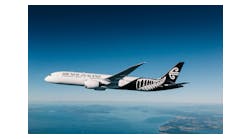Dec. 10--With the American Airlines and US Airways Group merger completed Monday, the hard work begins of integrating the carriers to create the world's largest airline.
US Airways chief executive officer Doug Parker, who leads the new American Airlines Group Inc., began the day by ringing the opening bell on the Nasdaq Stock Market, where the new company debuted under the ticker symbol "AAL."
"After today's celebration, the real work begins," Parker said in a message to employees. "These include integrating our networks, combining our frequent flier loyalty programs, and achieving a single operating certificate."
Parker and his executive team spearheaded the 2005 merger of America West Holdings and US Airways, so they know the drill.
In more than 300 cities where the new American will fly, 100,000 employees celebrated with sandwiches and cake.
At Philadelphia International Airport, where 6,600 US Airways employees are based, 5,500 hoagies were ordered.
It will take months -- maybe a couple of years -- to combine frequent flier programs, aircraft fleet, and workforces, as well as paint planes and integrate computer reservation systems.
In the meantime, both companies will continue to operate separate websites and flight schedules.
The biggest challenge will be avoiding the computer glitches that snarled passenger reservations systems after the 2010 airline merger of United and Continental.
US Airways' frequent fliers will be able to use their earned miles to book flights on American and "elite" travelers -- the most frequent of fliers, who have "chairman preferred" status -- will have baggage fees waived on American starting Jan. 7, as they do now on US Airways, said American's new president, Scott Kirby.
"While we will have reciprocity and recognition, we will still have different upgrade programs and lists," Kirby said in an interview. "It will be at least a year before the accounts will roll into one frequent-flier account."
As part of the merger, US Airways will leave the Star Alliance and join Oneworld, along with American, British Airways, Cathay Pacific, and Japan Airlines. Each network allows passengers to book flights and redeem travel miles on partner airlines around the world.
The new American, based in Fort Worth, Texas, said it will keep nine U.S. hubs, including Philadelphia.
In "break" rooms, aircraft hangars, and crew lounges, employees gathered Monday to celebrate.
"It's a very exciting day," said Michael A. Brown, senior US Airways ticketing supervisor. "I have seven or eight more years with the company before I retire. But the young agents have a full career ahead of them, and this brings stability in a much greater way."
Jimmy Brooks, American's general manager in Philadelphia, said the merger would "create all sorts of opportunities. Our employees are happy about it."
Passengers checking in for US Airways flights and others trying to rebook in Terminal B after weather-related delays Sunday wondered about the merger's effect on competition and fares.
"I think, certainly in Philadelphia, US Air has too much of the market and there's not good competition here," John Roddy of Orlando said on his way home after visiting relatives in Medford. "Philadelphia needs a lot more competition."
John Rouse of Riverside, Calif., said: "If you get too many of the airlines together, you don't have as much choice and then they raise the rates. That would be the only concern."
Passengers waiting to rebook flights complained that only two US Airways ticket agents were at counters helping customers. They said they hoped the new American would have more agents the day after a snowstorm.
Before the airlines can fully merge, the Federal Aviation Administration must grant American a single operating certificate, which could take until late 2015.
How smoothly airlines combine operations "comes down to three things -- labor, management, and information technology," JPMorgan Chase & Co. airline analyst Jamie Baker wrote in a client note.
For US Airways-American, labor has been supportive and "wages are largely known. Management has done this before," Baker said. "Accordingly, American's integration prospects appear better than average in our view."
215-854-2831
Copyright 2013 - The Philadelphia Inquirer




